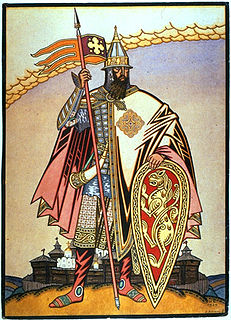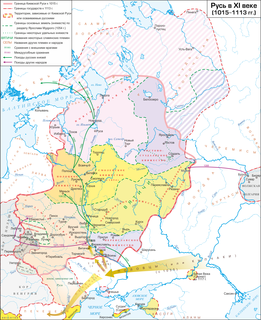
Year 1093 (MXCIII) was a common year starting on Saturday of the Julian calendar.

Vsevolod I Yaroslavich, ruled as Grand Prince of Kiev (Kyiv) from 1078 until his death.

Vladimir II Monomakh reigned as Grand Prince of Kievan Rus' from 1113 to 1125. He is considered a saint in the Eastern Orthodox Church and is celebrated on May 6.

Sviatopolk II Iziaslavich was supreme ruler of the Kievan Rus for 20 years, from 1093 to 1113. He was not a popular prince, and his reign was marked by incessant rivalry with his cousin Vladimir Monomakh.

Mstislav I Vladimirovich Monomakh, also known as Mstislav the Great, was the Grand Prince of Kiev, the eldest son of Vladimir II Monomakh by Gytha of Wessex. He is figured prominently in the Norse Sagas under the name Harald, to allude to his grandfather, Harold II of England. Mstislav's Christian name was Theodore.
Vsevolod IV Svyatoslavich the Red was a Rus' prince. His baptismal name was Daniil. He was grand prince of Kiev ; he was also prince of Chernigov (1204–1206/1208) and of Belgorod (1205).
Oleg Svyatoslavich was a Rurikid prince whose equivocal adventures ignited political unrest in Kievan Rus' at the turn of the 11th and 12th centuries.

Roman Mstislavich, known as Roman the Great was a Rus’ prince, Grand Prince of Kiev, member of the Rurik dynasty.

Prince Igor Svyatoslavich the Brave was a Rus’ prince. His baptismal name was Yury. Igor was prince of Putivl (1164–1180), of Novgorod-Seversk (1180–1198), and of Chernigov (1198–1201/1202).
The Battle of the River Bug, sometimes known as the Battle of Volhynia, was a battle that took place on 22–23 July 1018, in Red Ruthenia, near the Bug River and near Volhynia (Wołyń), between the forces of Bolesław I the Brave of Poland and Yaroslav the Wise of Kievan Rus, during the Bolesław's Kiev Expedition. Yaroslav was defeated by the Polish duke. It was part of the war of succession following the death of Vladimir the Great in 1015. Boleslaw supported his son-in-law, Sviatopolk, who was eventually defeated by Yaroslav.

The Battle of Alta River was a 1068 clash on the Alta River between Cuman army on the one hand and Kievan Rus' forces of Grand Prince Iziaslav I of Kiev, Prince Sviatoslav of Chernigov, and Prince Vsevolod of Periaslavl on the other in which the Rus' forces were routed and fled back to Kiev and Chernigov in some disarray. The battle led to an uprising in Kiev that briefly deposed Grand Prince Iziaslav. That incident supposedly shows the power of the Kiev veche and how common people gathering influenced princely politics in Kievan Rus'.
Boniak, Bonyak or Maniac, also known as Boniak the Mangy, was "one of the most prominent Cuman chieftains" in the late 11th century and the early 12th century. He headed a powerful Cuman tribe or clan that inhabited the steppes to west of the Dnieper River. He supported the Byzantines against the Pechenegs in the Battle of Levounion in 1091. He defeated Coloman, King of Hungary in 1097 or 1099.

Yaropolk Izyaslavich was a Knyaz (prince) during the eleventh-century in the Kievan Rus' kingdom and was the King of Rus (1076–1078). The son of Grand Prince Izyaslav Yaroslavich by a Polish princess named Gertruda, he is visible in papal sources by the early 1070s but largely absent in contemporary Rus sources until his father's death in 1078. During his father's exile in the 1070s, Yaropolk can be found acting on his father's behalf in an attempt to gain the favor of the German emperors and the papal court of Pope Gregory VII. His father returned to Kiev in 1077 and Yaropolk followed.
Rostislav Vsevolodovich was the Prince of Pereyaslavl (1078–1093), son of Vsevolod I of Kiev, and half brother of Vladimir Monomakh. He fought at Stugna river against the Cumans and drowned while fleeing the battle.

The Council of Liubech was one of the best documented princely meetings of Ruthenia that took place in Liubech in 1097. The council ended the war between the ruling Grand Prince Sviatopolk and the Prince of Chernihiv Oleh who fought for heritage of his father the Grand Prince Sviatoslav II.
Mstislav II Svyatoslavich was a Rus' prince. His baptismal name was Panteleymon. He was probably prince of Kozelsk (1194–1223), of Novgorod-Seversk (1206–1219), and of Chernigov (1215/1220–1223). He was killed in the Battle of the Kalka River.
Yaroslav II Vsevolodovich was a Rus’ prince. He was prince of Ropesk, of Starodub (1166–1176), and of Chernigov (1176–1198).

The Principality of Turov, also called Principality of Turov and Pinsk or Turovian Rus', was a medieval East Slavic principality and important subdivision of Kievan Rus' since the 10th century on the territory of modern southern Belarus and northern Ukraine. Princes of Turov often served as the Grand Princes of Rus early in 10th-11th centuries. The principality's capital was Turov and other important cities were Pinsk, Mazyr, Slutsk, Lutsk, Berestia, and Volodymyr.
Davyd Sviatoslavich was the ruler of Murom and Chernigov.
Iaroslav Sviatopolkovich, also known as Iaroslav or Yaroslav Sviatopolchich, was Prince of Vladimir-in-Volhynia from 1100 to 1118.











